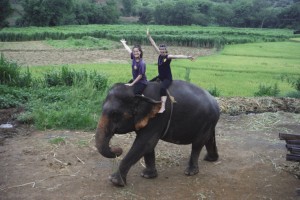The elephant in the room
Some travel adventures aren’t so ethical
Ali Hardstaff
Staff Writer

Ali Hardstaff and Melanie Walsh shown above riding an elephant in Thaliand in summer 2014.
Photo courtesy: Ali Hardstaff
I was in the middle of the jungle, gliding along atop Willie Nelson’s back, feeling his coarse skin and trying to not fall off when an unexpected dip emerged on the path. Myself and Willie, an elephant, were heading down to the river to play, trekking through the trees on the outskirts of Chiang Mai, Thailand. I was having one of the most marvelous experiences of my life.
That was what I thought, at least up until I learned some background about elephant trekking.
It was recently shared with the public that the Ringling Bros. circus will no longer features elephants as of 2018 and instead focus their efforts on elephant conservation.
According to an article by the National Geographic , a Feld Entertainment (Ringling Bros. parent company) executive vice president Alana Feld said, “a lot of people aren’t comfortable with us touring with our elephants.”
So I started thinking more of my own experience with the animals, what I thought to be one of the most spectacular ones of my life.
Though I acknowledge that I was ignorant and ill-prepared in many ways. One in particular that I am now sharing, is one that I was most eager for when planning the trip. Having an experience with the larger than life animals, elephants.
Before travelling to Thailand, I was mildly aware of what is happening to animals in that country; the attractions that pull in tourists without them knowing all of the dirty details or the real goings-on.
However, the girls I was travelling with and I believed we chose wisely when we were in Thailand. We stayed at Deejay Backpackers for a few nights in Chiang Mai, one of the best hostels of the entire trip. The owner was chill and straightforward, the rooms were clean, comfortable and cheap.
While deciding where to go for our elephant trekking adventure, we spoke to the owner of the hostel. He recommended Eddy Elephant, saying it was one of the good and ethical places to experience. We booked it and left the next morning.
We were spending time with the elephants, going through the commands and how to properly climb on to their backs, and how to hold out a banana so their trunks can take it from your outstretched arm.
“Eddy Elephant camp in Chiang Mai is not a circus, not a show, not an elephant park, not a sanctuary or a farm, there is no elephant painting and no platform, this is real experience making you and your elephant be very close. This is Fair Trade Tourism and profit to locals people,” says the website in Thai-English.
Many do not think that any elephant domestication is ethical, for several reasons.
The international non-profit animal welfare organization, World Animal Protection, (formerly the WSPA), for example, who’s purpose is to, “Help us engage more tourists, tour operators and governments around the world to unite over one belief: wild animals belong in the wild,” and Intrepid Travel (adventure travel company) together conducted research in Asia from 2010 to 2011 on captive elephants.
The main points raised against elephant tours and trekking, according to Right Tourism, and the animal rights organization known as People for the Ethical Treatment of Animals (PETA) include bullhooks that are used when training, chaining and riding elephants.
According to PETA, “Their skin appears deceptively tough, but in reality it is so delicate that an elephant can feel the pain of an insect bite. A bullhook can easily inflict pain and injury on an elephant’s sensitive skin.” Also, having the elephants chained restricts their movement, keeps interaction limited and keeps these social animals isolated from each other.
Right Tourism indicates that the saddles and harnesses used by some when riding can cause physical harm to the elephant. Intrepid is against elephant riding of any kind.
It says on their website, “Compassionate travellers should avoid riding wild animals such as elephants for entertainment, because these animals are often captured from the wild, inadequately cared for and usually trained using inappropriate and cruel methods.”
In my experience, the bullhooks were used, but although there were no visible injuries on any of the elephants that indicated misuse, I don’t fully know to what extent the elephants were feeling pain.
The elephants were chained at some points during the day, when we went to feed them the bananas. It was explained to us that this was to ensure they do not roam into the jungle and not return. Although, it has to be noted that the group of them were all together under one roof, not isolated.
When we came to the spot where we climbed atop the elephants for the trek to the river, the elephants were roaming freely with their legs unchained.
The fact remains, though, that these elephants are no longer free and in the wild.
No one will ever have every miniscule fact and all-encompassing information on every subject matter. But it is up to individuals to do their best to educate themselves before partaking in the unfamiliar.
In the moment, I felt free. I am not an elephant whisperer, but I would like to think that I would have gotten a sense if Willie was discontent in any way. Hopefully my senses were not diluted in that way.
I would be lying if I said that being on top of the elephant wasn’t what I thought to be one of the best experiences of my life.
Now I know better.


